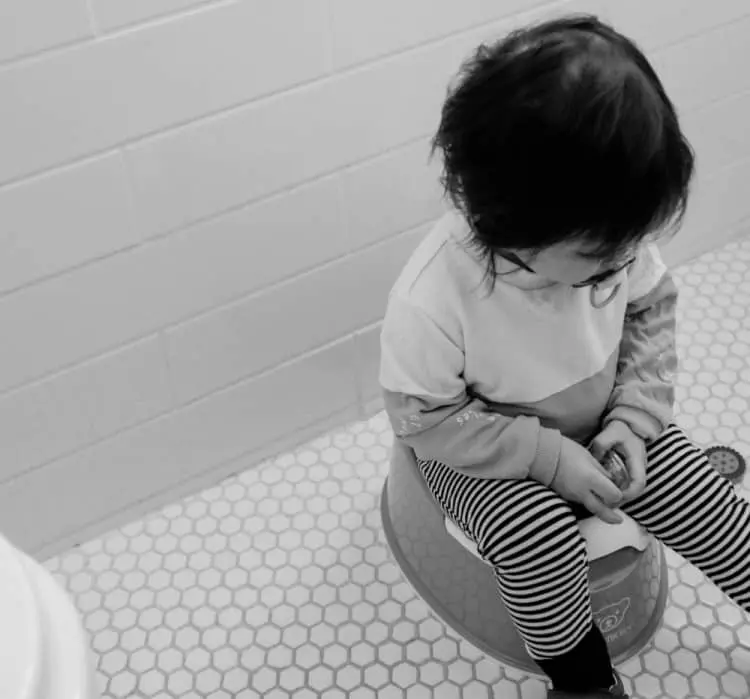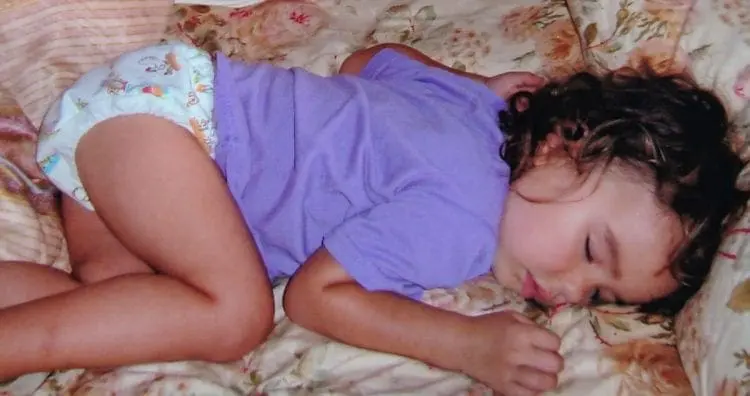Potty training can be a daunting task and often times parents find themselves frustrated with a stubborn toddler who simply refuses to participate. Here are 6 must-read tips potty training tips to help you and your toddler succeed without frustration. I also include a section with nighttime potty training tips. Potty training can be a significant milestone for toddlers and their parents. Starting with the right approach can make all the difference. Using tools like a potty chair or potty seat, along with positive reinforcement such as sticker charts, can help make the experience feel fun and rewarding.It’s essential to remain supportive, patient, and understanding throughout the process. Here are some tips that will help.
6 Potty Training Tips to Help Even The Stubborn Toddler Succeed
Toilet training is a big deal for both kids and parents. Potty training can feel daunting, but with patience and consistency, it becomes manageable. First, watch for readiness signs and don’t start before they are ready. You want to set them up for success and keep your expectations realistic. Every child trains at their own pace. The American Academy of Pediatrics (AAP) recommends starting when a child shows signs of physical and emotional readiness—usually between 18 and 24 months, but sometimes later—and emphasizes a positive, child-led approach.
Watch for Signs of Readiness
There is nothing more frustrating than trying to potty train a toddler who is simply not ready. Keep an eye out for signs of readiness to ensure you’re starting at an appropriate developmental stage. These signs include: urinating in larger amounts with dry periods of at least 2 hours throughout the day, having predictable bowel movements, the ability to pull pants up and down, sit quietly in one place for two to five minutes, and understand simple directions. Toddlers who are ready will usually show discomfort in a dirty diaper and give physical or verbal cues when they’re urinating or having a bowel movement. It’s a good idea to wait until your child is ready to avoid power struggles and encourage a smooth transition to big-kid underwear.
Make Potty Training Fun
All kids want is to have fun, especially with their parents and caregivers. Creating potty songs or having a special set of books and toys for use only while sitting on the potty can make it more exciting for a reluctant toddler.
Celebrate Their Potty Training Accomplishments
There is no better motivator than pride and toddlers will beam when they know you’re offering them a hearty “Good job”. Celebrate even the tiniest accomplishments, from knowing they have to go even if they don’t make it to sitting on the potty for an allotted amount of time even if they don’t go. And of course save the biggest celebration of all for when they successfully do their business in the right place. This will encourage them to keep trying. You might want to try a potty training sticker chart to help reward them.
Maintain Patience During Potty Training
Keeping your cool is key to encouraging a stubborn toddler to continue the potty training journey. Accidents should not be scolded, but addressed calmly. It can be a frustrating time for both parents and children, so be prepared to exercise your patience throughout the day. You can maintain your patience best when you can set some time aside for potty training. Begin potty training when it can be your main focus for the day.
Invest in Big Kid Underwear
Many parents find training pants like pull ups to be a hindrance to the potty training process. It’s too easy for toddlers to continue to use these pants as they would a diaper. Invest in some exciting big kid underwear that are emblazoned with their favorite characters.
Prepare for Potty Training Incidents
Carry extra underwear and pants when you go out in case of accidents. Have plenty of towels and cleaner on hand at home and plenty of wipes and plastic bags in the car for the go clean ups. Keep calm and encourage your child because you don’t want them to associate trying to use the toilet with stress. Most kids don’t like finding they accidentally wet their pants, so help them change quickly and let them know it will be OK.

Potty Training Tips for Girls
When potty training girls, start by helping them recognize the urge to go and encourage sitting on the potty with feet supported. Some kids may want to just sit it on first and get used to the child-size potty chair. Teach proper wiping from front to back to avoid infections, and consider having them wear dresses or easy-to-remove clothing for quicker potty access. Let her watch a trusted female role model (like mom) use the toilet to reinforce learning through imitation. Celebrate successes with encouragement and small rewards, and stay patient through accidents, keeping the experience positive and pressure-free.
Potty Training Tips for Boys
For boys, it often helps to begin potty training sitting down to make pooping and peeing less confusing. Once they’re comfortable, you can introduce standing up by letting them observe dad or an older brother. Use fun targets like cereal pieces in the toilet to make aiming a game. Make sure they understand how to shake off and wipe if needed, and remind them to wash hands every time. Keep clothing simple for quick removal, and be consistent and upbeat as they build confidence with each try.
Nighttime Potty Training Tips

Now, nighttime potty training is a whole other beast. It really depends on the child. My son just naturally didn’t wet his diapers overnight when he got to be around 18 months. I was shocked because that was not my experience with my daughter who only learned nighttime potty training after mastering day time potty training somewhere after the age of 2.
Most children become developmentally ready to nighttime potty train between the ages 2 and 3. Also like my daughter, they usually master nighttime potty training only after mastering daytime potty training. This is because most toddlers will have to use the bathroom at night at first and have to learn to get up and go. This is obviously a whole new challenge.
You can’t teach a toddler not to pee in their sleep if they are not waking up and noticing the urge. Nighttime potty training should almost not be called “training” because it is more about being set up for success and being biologically ready.
How To Know When A Toddler Is Ready For Potty Training Overnight
As I mentioned before most kids become ready to start nighttime training after they master day time training between 2 and 3. Once they are very consistent and have very few accidents, then you may decide to start nighttime training too.
In order to make the decision to nighttime potty train, I would gather some information for yourself about your child. Each night before your toddler goes to sleep make sure they have a brand new diaper right before you tuck them in. Then each morning when your toddler wakes up immediately check their diaper and see how much wetness there is by how heavy and full it feels. If the diaper is very full, they may not be developmentally ready to have to get up a few times in the night and go pee. If it is pretty lightly used, it may be a good time to start.
How To Set Your Toddler Up For Nighttime Potty Training Success
I set my kids up for nighttime potty training success by decreasing their liquid intake after dinner time. They could still have something to drink if they were thirsty but water was the only option. Only water ensures they are actually thirsty and not just in the mood for a sugary juice and it also usually results in less liquid in the bladder. Decreasing liquid before bedtime is a huge factor in setting your child up for nighttime potty training success.
The second biggest factor in setting your child up for overnight potty training success is making going potty the last thing they do before they go to bed every night. It needs to become part of their routine to empty the bladder (or at least try) as the last thing they do before going to sleep.
Nighttime Potty Training Methods
Once you have set the stage for success with the above nighttime potty training tips, you can then use one of the two methods below:
- Let them keep wearing diapers or pull ups. Then just monitor them and see if they start waking up dry, like my son did. Celebrate their successes and thank your lucky stars!
- Put down a waterproof mattress cover pad and let your toddler use padded training underwear. This way their accidents are minimized. This is the way I did it with my daughter but I only tried this once she was good at daytime potty training and her diaper was most often empty in the morning.
Personally, I suggest the first method, as it is so much easier for everyone involved. I would however, move to method two if your child is 3 or over. And remember that even when kids start to master nighttime potty training, they may still have occasional mistakes all the way up to age 5. That is completely normal. So once they seem to have graduated from method 1, I would proceed to method 2, just as back up!
Conclusion
Potty training is a big step that takes time, patience, and plenty of hard work, but the rewards are well worth it. After so many diaper changes, seeing your child stay in a dry diaper or ask to go potty first thing in the morning is a huge accomplishment. While there may still be the occasional accident, each success brings your child closer to the next step of independence. Keep a portable potty handy for outings, stock up on toilet paper, and offer lots of praise to build confidence. Take a deep breath—your child is learning, and you’re both doing great.
By creating an air of excitement around potty training, celebrating their accomplishments, and preparing for potty time disasters, you can encourage your stubborn toddler to take another step into the world of big kids. I hope you find these potting training tips to be useful. I’d love to hear about your experiences with potty training and success stories in the comments.
Related Posts:


Jessica says
These are great tips! The big ones to me are staying calm and not scolding. Scolding can have a negative impact and prolong the process. Pull-ups prolonged my son’s night-time potty training (we never used them during the day), so with my daughter we only used underwear and she has never had a problem at night. And key to going out is having extra clothes. Without them, you are SOL. So bring them! You also get great tips, a free night-time potty training e-book and tons of resources. Anyways. This was a great post! Thanks and good luck to everyone!